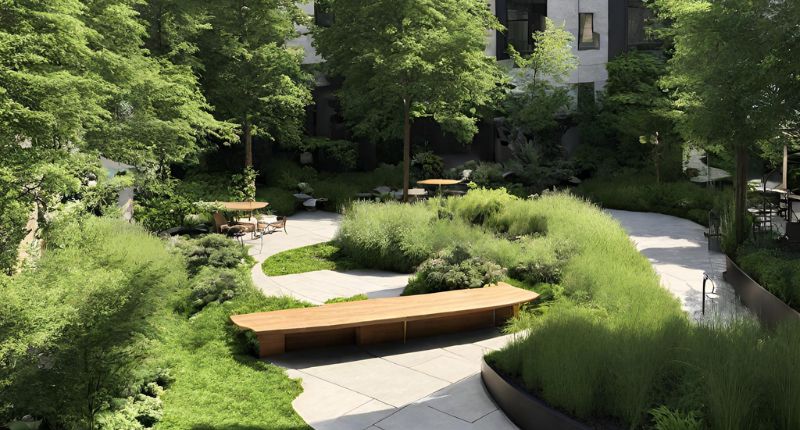
- Pocket parks enhance urban life, supporting mental health, physical well-being, and community bonding.
- Mitigating urban heat and repurposing underutilised land, making cities more livable.
- Vital tool for local governments to create accessible public spaces in densely populated cities.
With around three-quarters of Australians living in the major cities, a figure that will only increase as time passes, local governments are facing mounting pressure to carry out the insurmountable task of provisioning more green spaces in highly populated, land-poor areas.
“One of the issues from an urban liveability perspective is that with increasing population density, we need more public space,” says University of New South Wales (UNSW) Arts, Design & Architecture senior lecturer in urban design and landscape architecture from the School of Built Environment, Dr Mike Harris.
Enter pocket parks, bite-sized parks equipped with similar features as their full-sized counterparts, including eating, greenery, and shading, albeit at a smaller scale.
What are pocket parks?
Pocket parks are small parks of less than 5,000 square metres (sqm) accessible to the public. Though small in stature, these parks have the potential to drastically improve the liveability of the urban areas around them.

A 2021 literature review published in Urban Forestry & Urban Greening on the usage of pocket parks found consistent evidence of improved mental well-being, physical health, and social benefits.
The report’s authors, Praveena Balai Kerishnan and Sreetheran Maruthaveeran, note that park features like green ground cover, ground cover, bushes, trees, flower beds, water features, and a calm atmosphere away from traffic, were strongly linked with better mental health.
Components like benches, water features, walking paths, cafes, and adequate stationary space enhance socialising.
Additionally, the research found that pocket parks encouraged more physical activity in dense cities by motivating inhabitants to walk to the closest pocket park.
Greening urban concrete jungles
Pockets parks are well suited for dense urban areas where larger public parks are unfeasible and where land is scarce and expensive. Already a staple of Sydney’s inner west, more pocket parks are in the pipeline for the eastern suburbs where public spaces have been neglected in planning regulations.
“The city has big public gestures like Centennial Park, but it wasn’t master planned to have many smaller parks in its subdivisions,” says architect and PhD candidate at the School of Built Environment, Ela Glogowska.
“So, it’s no surprise that today we have a massive deficit of accessible public socialising areas.”
Many pocket parks are built opportunistically by repurposing underutilised land. For instance, the local government may buy a land lot, usually derelict or unsuitable for commercial development, replacing it with a park. Another way that governments can build pocket parks is by reclaiming part of a public street.

“The idea behind pocket parks is to get more out of the space we have in cities, and the ideal place in the existing public domain is our street network,” Dr Harris says.
“Usually, that’s a closure to cars and converting a small portion of the street into a useable recreational space that the whole community can enjoy.”
One advantage of pocket parks is that they can be strategically installed throughout a neighbourhood, increasing accessibility and public space usage.
“The amount of public space is essential, and we do still need our large public commons, but distribution and proximity are just as important,“ Harris says.
“Having more of these smaller pocket parks can make accessing public space more incidental and a part of daily life, rather than an event you must plan for and go out of your way to access.”
“Having more open and accessible public spaces for residents plays an essential role in building a sense of community.”
Ela Glogowska, Architect and PhD candidate
“These are the places where people bond, interact and enjoy life, which is why we want to live in cities in the first place.”
Providing refuge in Australia’s sweltering heat
An added benefit of pocket parks is that they give more greenery and tree cover in urban cities, providing refuge from the heat.

“Our urban areas are getting hotter, and we know one of the ways we can mitigate against that is through trees that have a cooling effect,” Dr Harris says.
“Pocket parks can help us find additional space to develop and expand the canopy cover for our cities.”
Pocket parks can also be customised to suit the local community’s needs. For instance, pocket parks in town centres may be fashioned like a plaza with more tables and seating for workers, while parks built in residential areas may have play equipment for children.
“They’re a fantastic opportunity for council to deliver a community asset, cost-effectively and with minimal disruption, and listen and respond to the needs of the local population through design,” Dr Harris says.
“If we want to start to improve the quality of our public domain, anything we can do to prioritise people more helps to do that.”
Though pocket parks are not the panacea for liveability by themselves, they are another potent tool that local governments can use to provide more public space for communities living in the cities.
“We must consider public spaces as social infrastructure and value them in terms of their wellbeing benefits,” Glogowska says.
“If we want a healthy and happy society, we need a diversity of quality public spaces for the public to enjoy, and more pocket parks will certainly contribute to that.”







